The way her career is headed, soon we’ll be able to collate an Ana Lily Amirpour map of the United States. A Girl Walks Home Alone at Night was set in a fantasized Iran––the country of her family heritage––although the most Californian sun and tarmac-parched Iran you could imagine. The Bad Batch was her Texan border town cannibal freakout––where out-of-commission ‘90s Hollywood stars like Jim Carrey and Keanu Reeves wandered the Mad Maxian wastelands. Mona Lisa and the Blood Moon (a twee title for a film with serious bite) takes one of the most touristically fetishized parts of the US––New Orleans––as its milieu and playground. It doesn’t quite shed the sense of an outsider looking in, extracting the most photogenic and Instagrammable parts for an artfully scuzzy collage, but the emerging theme of Amirpour’s work is actually that of outsider-dom, depicted in a way that’s honestly empowering. (The Bad Batch, in its treatment of physical disability, for instance, is one of the more body-positive films of its era.)
Major kudos to her casting team too. To quote David Cronenberg, casting for feature films is one of the “dark arts.” Amirpour and her casting trio on this film––Justine Arteta, Elizabeth Coulon, and Kim Davis-Wagner––have a very unique sense of it. From Lee Chang-dong’s Burning, we have Jeon Jong-seo as Mona Lisa Lee, excelling here as a young North Korean woman, a mental inpatient for half her life, with dangerous psycho-kinetic abilities. Kate Hudson is the mouthy stripper Bonnie, who rescues her after she escapes from the high-security facility, but then seeks to take monetary advantage of her violent skills. Craig Robinson, invertedly cast in a non-comedic role, is Officer Harold, the good N’awlins cop on her trail. He is injured in his first confrontation with Mona Lisa, and paddles along for the rest of the film on crutches––a great film noir touch.
There’s a hot potato aspect as well to Mona Lisa and Blood Moon, an independence of mind and spirit that doesn’t care what might be politically correct; the script especially feels her own, carefully guarded from what various financiers might be inclined to give notes on. Ed Skrein’s drug dealer character Fuzz dances on the boundary of appropriateness with regards to his appropriation of African-American culture, and he’s yet another character who doesn’t condemn or persecute Mona Lisa, so much as see how he can exploit her for his own gain. Making her North Korean is interesting as well: there’s a Trump-era resonance here (it was shot in 2019, and delayed) regarding escalating tensions with North Korea, and Amirpour subtly hints that Mona Lisa is a foreign agent engaged in subterfuge. And also someone just unfairly treated and misunderstood, creating some empathy for her outbursts of violence and resistance.
There was a term used in the British music press of the 1980s to describe arty post-punk bands like Gang of Four, Wire, and Siouxsie and the Banshees: a particular “art school” sensibility. Amirpour’s work here and elsewhere has that in spades: a design aesthetic that feels very considered and deliberate, drawing from eclectic sources––you can feel the pre-production lookbooks and fathom the hours trawling books and the internet for reference points. Her production design here can look like a pop-up faux-speakeasy––in, say, a fashionable part of a big city––in the best possible way, and the film gains extra distinction from its nighttime cinematography by Ari Aster’s genius DP Pawel Pogorzelski, and the eye-popping colors and neon flares that burst out of the locale’s swampy dusk.
The sentimental undertow of Bad Batch is also reprised, to slightly better effect. Hudson’s character has a precocious, sludge metal-loving young son Charlie (Evan Whitten), and he and Mona Lisa make a beautiful connection, a friendship which we sense could even tip into an age-gap romance. As we reach the film’s climax, an interesting decision is made to forgo a big, meaty set-piece, considering what terrible, vengeful power Mona Lisa has––I wondered if this was a budgetary limitation. But as Fuzz mischievously says to her at a key climactic point: “I’ll see you in the sequel!”
This is a midnight movie/B-movie-type work that knows exactly what it is––there’s no pretensions of “elevated horror” here. Mona Lisa is smart, politically aware, and reaffirms a bit of faith in Amirpour’s talent.
Mona Lisa and the Blood Moon premiered at Venice Film Festival.

